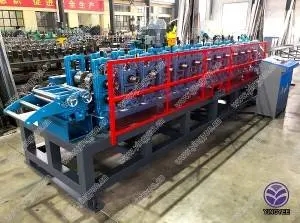
Understanding Purlin Roll Forming Machines An Overview
Purlin roll forming machines play a pivotal role in the construction and manufacturing industries, particularly in the production of purlins, which are essential structural components in buildings. Purlins are horizontal members used to support the loads from the roof deck or wall, transferring these loads to the vertical structures of the building. The efficiency and precision of purlin roll forming machines have made them invaluable assets for businesses seeking to streamline their operations and enhance productivity.
A purlin roll forming machine is designed to convert flat steel sheets into purlin profiles through a series of rolling stations. These machines operate by feeding the flat metal sheets into the rollers, which shape the material into the desired profile, typically C or Z shapes. The process is automated, allowing for high levels of precision and uniformity, which are essential in construction where structural integrity is paramount.
The key advantages of using a purlin roll forming machine include reduced labor costs, minimal material waste, and the ability to produce custom profiles with varying dimensions. Moreover, these machines can operate at high speeds, significantly expediting the production process. This efficiency not only increases output but also keeps production costs low, making it a cost-effective solution for manufacturers.

Modern purlin roll forming machines come equipped with advanced technology, including computerized controls that enable operators to easily switch between different profiles and specifications. This flexibility is a substantial benefit for manufacturers who need to adapt to changing demands in the market or cater to specific customer requirements. Additionally, these machines are often designed to allow quick changeovers between production runs, further enhancing operational efficiency.
Another significant aspect of purlin roll forming machines is their capacity for producing high-quality products. The precision of the roll forming process minimizes the risk of defects and inconsistencies, ensuring that the purlins meet rigorous industry standards. This reliability in quality is crucial for construction projects where safety and durability are critical.
Furthermore, the integration of robotic systems into purlin roll forming machines is becoming increasingly popular. Robotic arms can be used for tasks such as loading and unloading material or even performing inspections, thus reducing the risk of human error and enhancing overall workplace safety.
In conclusion, purlin roll forming machines are indispensable tools in the modern construction landscape. Their ability to produce high-quality purlins efficiently and cost-effectively makes them essential for manufacturers looking to thrive in a competitive market. With advancements in technology and automation, these machines continue to evolve, paving the way for even greater efficiencies and capabilities in the future. As the demand for purlins in construction grows, investing in a reliable purlin roll forming machine becomes a strategic move for any manufacturing business aiming for success in the industry.